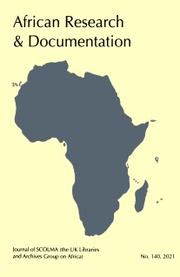Article contents
Change in African Vegetation
Published online by Cambridge University Press: 25 April 2022
Extract
A common element in all African studies is the background of the African environment. My first real sight of Africa, thirty years ago, was in the long train journey from Lagos to Zaria. As a botanist, I was fascinated then by the changing patterns of vegetation — different kinds of forest and savanna, a rich diversity of plant species. I suppose all members of our Association have seen something of Africa's vegetation and, especially on long journeys, may have thought it monotonous and dull. However, as with all forms of scholarly inquiry, what at first sight seems uniform becomes, on close inspection, a puzzling jumble, and only after a fair amount of study do meaningful patterns and causal relationships emerge. My interest was aroused by that very obvious part of the African environment and over the years I found that my vegetational studies were often relevant to researchers in quite different disciplines.
- Type
- ASAUK Presidential Address
- Information
- Copyright
- Copyright © International African Institute 1973
References
- 1
- Cited by


